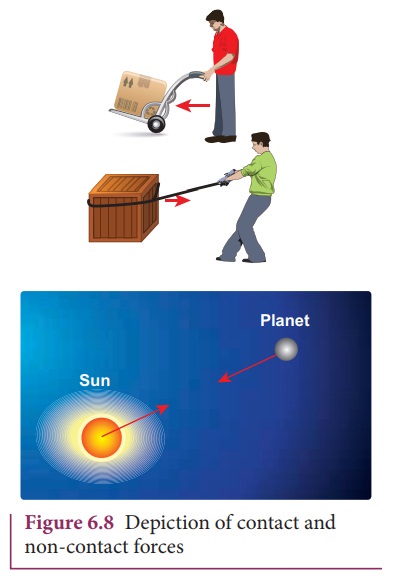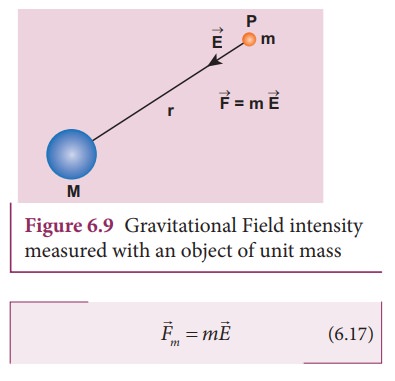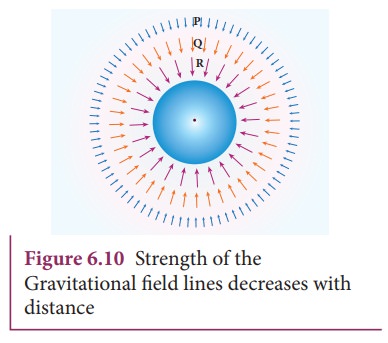Chapter: 11th Physics : UNIT 6 : Gravitation
Gravitational field
Gravitational
field
Force
is basically due to the interaction between two particles. Depending upon the
type of interaction we can have two kinds of forces: Contact forces and
Non-contact forces (Figure 6.8).

Contact
forces are the forces applied where one object is in physical contact with the
other. The movement of the object is caused by the physical force exerted
through the contact between the object and the agent which exerts force.
Consider the case of Earth orbiting around the Sun.
Though the Sun and the Earth
are not physically in contact with each other, there exists an interaction
between them. This is because of the fact that the Earth experiences the
gravitational force of the Sun. This gravitational force is a non-contact
force.
![]()
![]() It sounds mysterious that the Sun attracts the Earth despite
being very far from it and without touching it. For contact forces like push or
pull, we can calculate the strength of the force since we can feel or see. But
how do we calculate the strength of non-contact force at different distances?
To understand and calculate the strength of non-contact forces, the concept of
ŌĆśfieldŌĆÖ is introduced.
It sounds mysterious that the Sun attracts the Earth despite
being very far from it and without touching it. For contact forces like push or
pull, we can calculate the strength of the force since we can feel or see. But
how do we calculate the strength of non-contact force at different distances?
To understand and calculate the strength of non-contact forces, the concept of
ŌĆśfieldŌĆÖ is introduced.
The
gravitational force on a particle of mass ŌĆśm2ŌĆÖ due to a particle of
mass ŌĆśm1ŌĆÖ is

Where
rˆ is a unit vector that points from m1 to m2 along the line joining the masses m1 and m2.
The
gravitational field intensity ![]() (here after called as gravitational field) at a point which is at a distance r from m1 is defined as the gravitational force experienced by
unit mass placed at that point. It is given by the ratio
(here after called as gravitational field) at a point which is at a distance r from m1 is defined as the gravitational force experienced by
unit mass placed at that point. It is given by the ratio ![]() /m2 (where m2 is the mass of the object m2 on
which
/m2 (where m2 is the mass of the object m2 on
which ![]() acts)
acts)

Using![]() =
= ![]() /m2 in equation (6.14) we get,
/m2 in equation (6.14) we get,![]() is a vector quantity that points towards the mass m1 and is independent of mass m2, Here m2 is taken to be of unit magnitude . The
unit rˆ is along the line between m1 and the point in question.
The field
is a vector quantity that points towards the mass m1 and is independent of mass m2, Here m2 is taken to be of unit magnitude . The
unit rˆ is along the line between m1 and the point in question.
The field ![]() is
due to the mass m1.
is
due to the mass m1.
In
general, the gravitational field intensity due to a mass M at a distance r is
given by

Now
in the region of this gravitational field, a mass ŌĆśmŌĆÖ is placed at a point P
(Figure 6.9). Mass ŌĆśmŌĆÖ interacts with the field ![]() and experiences an attractive force
due to M as shown in Figure 6.9. The gravitational force experienced by ŌĆśmŌĆÖ due
to ŌĆśMŌĆÖ is given by
and experiences an attractive force
due to M as shown in Figure 6.9. The gravitational force experienced by ŌĆśmŌĆÖ due
to ŌĆśMŌĆÖ is given by

Now
we can equate this with NewtonŌĆÖs second law 

In
other words, equation (6.18) implies that the gravitational field at a point is
equivalent to the acceleration experienced by a particle at that point.
However, it is to be noted that ![]() and
and ![]() are separate
physical quantities that have the same magnitude and direction. The
gravitational field
are separate
physical quantities that have the same magnitude and direction. The
gravitational field ![]() is
the property of the source and acceleration
is
the property of the source and acceleration ![]() is the effect experienced by the test mass (unit mass) which is
placed in the gravitational field
is the effect experienced by the test mass (unit mass) which is
placed in the gravitational field ![]() . The non-contact interaction between two masses can now be
explained using the concept of ŌĆ£Gravitational fieldŌĆØ.
. The non-contact interaction between two masses can now be
explained using the concept of ŌĆ£Gravitational fieldŌĆØ.
Points to be noted:
i)
The strength of the gravitational field decreases as we move away from the mass
M as depicted in the Figure 6.10. The magnitude of ![]() decreases as the distance r increases.
decreases as the distance r increases.

Figure
6.10 shows that the strength of the gravitational field at points P, Q, and R
is given by  . It can
be understood by comparing the length of the vectors at points P, Q, and R.
. It can
be understood by comparing the length of the vectors at points P, Q, and R.
ii) The ŌĆ£fieldŌĆØ concept was introduced as a mathematical tool to calculate gravitational interaction. Later it was found that field is a real physical quantity and it carries energy and momentum in space. The concept of field is inevitable in understanding the behavior of charges.
iii) The unit of gravitational field is Newton per kilogram (N/kg) or m s-2.
Related Topics